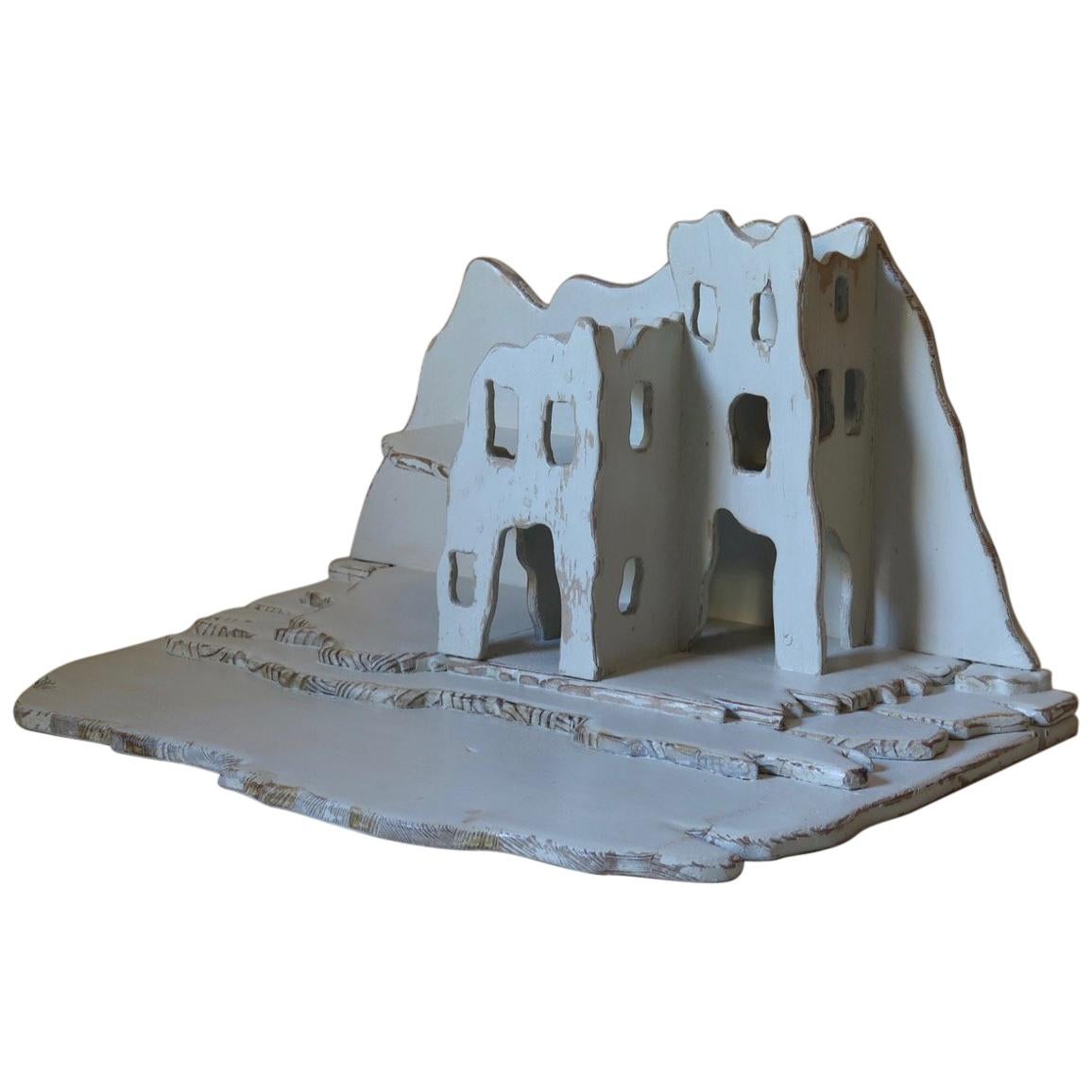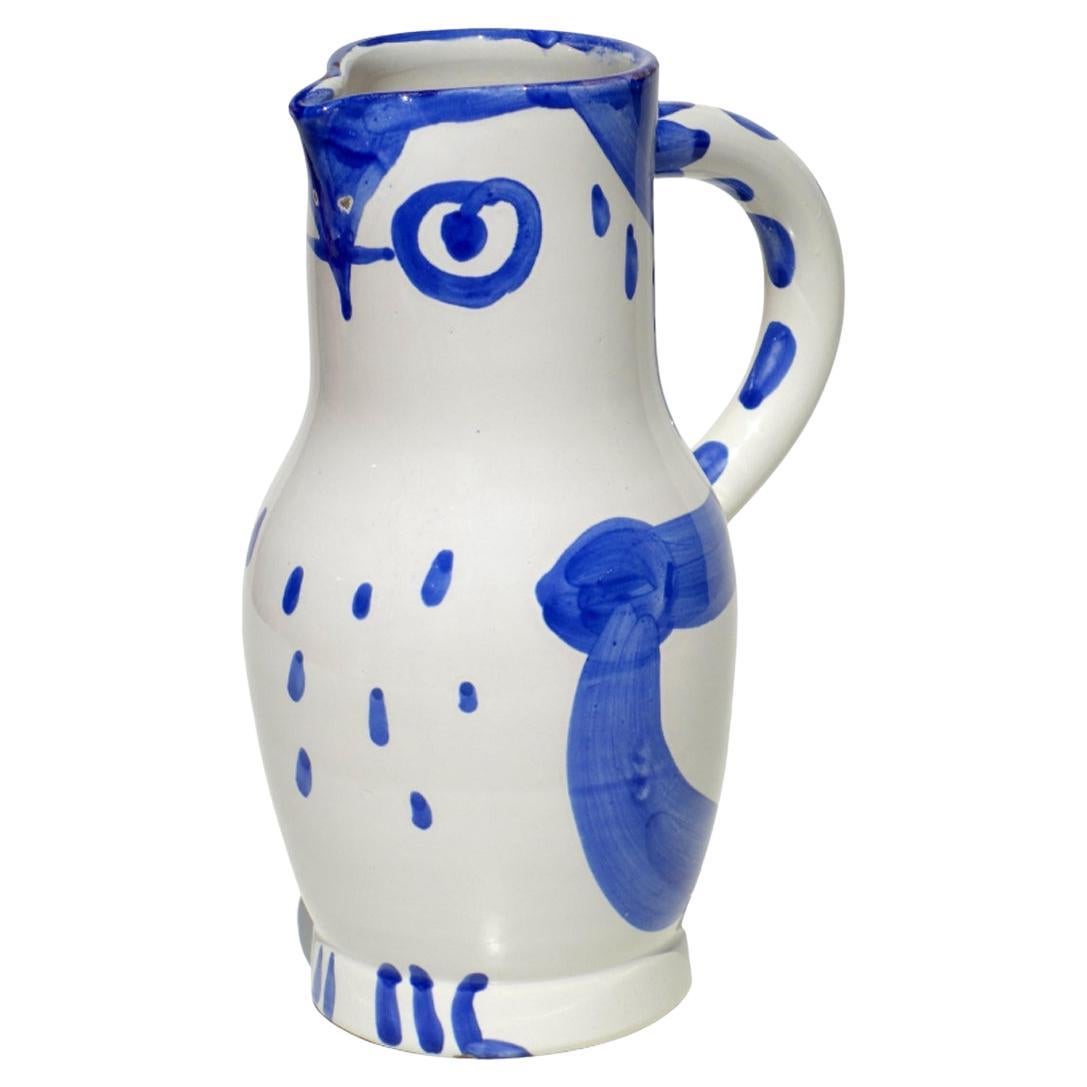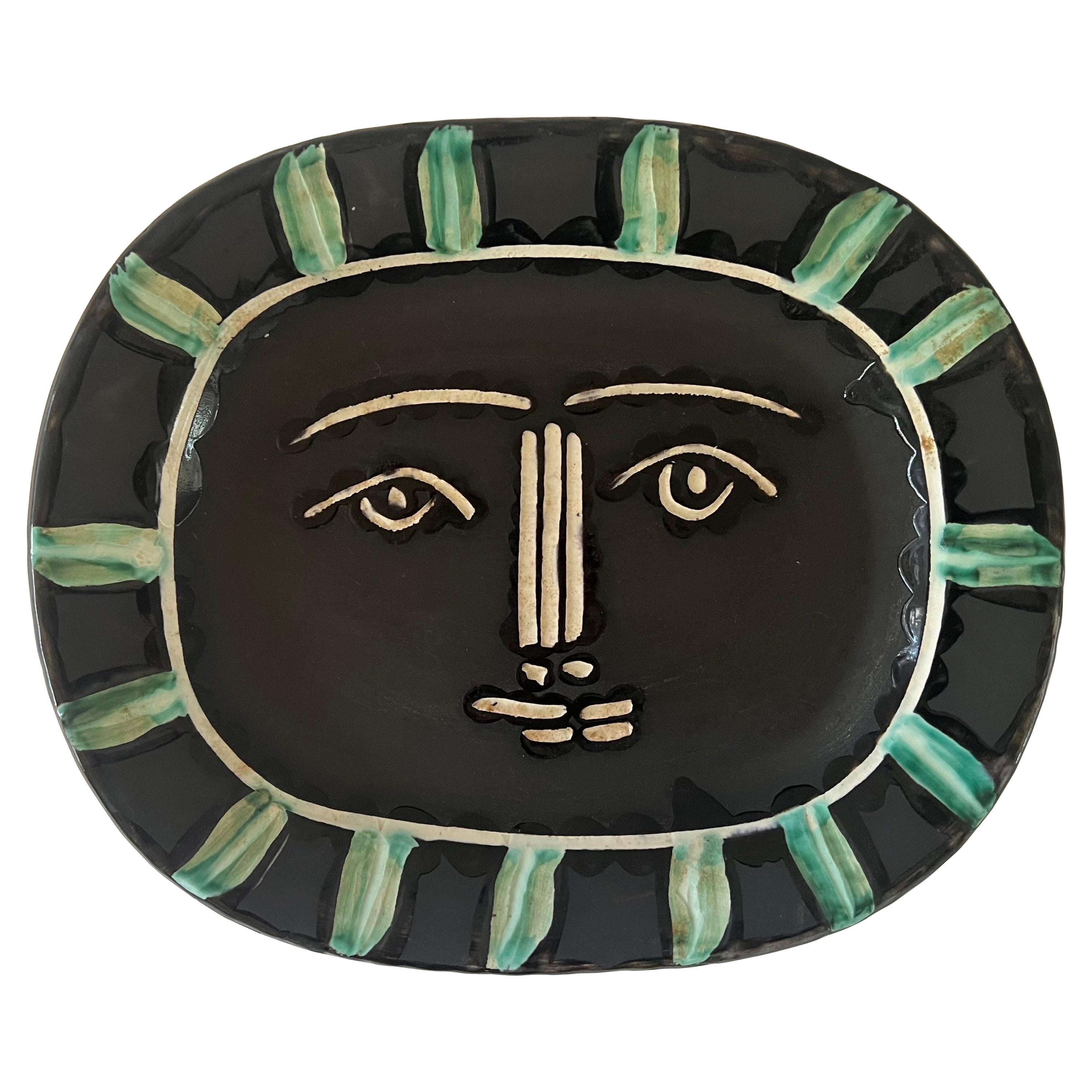Items Similar to Ceramic Easter Egg from Atelier Madoura, circa 1960s
Want more images or videos?
Request additional images or videos from the seller
1 of 10
Ceramic Easter Egg from Atelier Madoura, circa 1960s
About the Item
Vintage ceramic egg figure from Atelier Madoura, Vallauris, France (circa 1960s). This egg-sized ceramic figure is painted with a stylized suited man with a smile on his face. It is a simply but elegantly painted work with many charms and would certainly be a conversation piece for your home or work place. It was created in the Madoura pottery which Picasso made so famous. In good vintage condition, the piece is unsigned. Please see the photos accompanying this listing. Upon request a video of the ceramic may be provided. This gallery holds another very similar figure and would be ideal as a set. This is the larger egg of the two.
About Atelier Madoura: Picasso became quickly enamoured with the ceramics being produced by L'atelier Madoura and asked to be introduced to Georges and Suzanne Ramié, the owners of the pottery studio. Suzanne Ramié had played a pivotal role in the revival of traditional pottery from the South of France, and made a name for herself with innovative designs based on her reinterpretations of their traditional forms and glazes. The Ramiés invited Picasso to their Madoura Pottery workshop, where they introduced him to various techniques and Picasso created three small sculptures in clay (a faun’s head and two bulls) which he left to dry and bake. According to Georges Ramié, when he and his wife returned to see the works and continue their visit, Picasso had vanished without a trace. Twelve months later, the artist returned, unexpectedly and completely unannounced, to see how the pieces had turned out. He was shown the sculptures, and delighted, he immediately asked when he could “get back to work.” The Ramié’s agreed to set aside an area of the workshop where he would begin producing his own ceramics, ushering in one of the most prolific periods of his career; in just over two decades, Picasso would create over 3,500 works in clay. It is of note that after his death, every object in his estate was photographed, other than his ceramics, of which there were many; due to the second-class status traditionally accorded to the art of pottery they were for a long time a source of derision and embarrassment for much of the art world. The Atelier Madoura however became world famous and known for inspiring Picasso to create such amazing works.
Dimensions:
H 9.5 cm / 3.7"
W 7.5 cm / 3.0".
- Creator:Madoura (Workshop/Studio)
- Dimensions:Height: 3.75 in (9.5 cm)Diameter: 2.96 in (7.5 cm)
- Style:Mid-Century Modern (Of the Period)
- Materials and Techniques:
- Place of Origin:
- Period:
- Date of Manufacture:circa 1960s
- Condition:
- Seller Location:London, GB
- Reference Number:
About the Seller
5.0
Platinum Seller
These expertly vetted sellers are 1stDibs' most experienced sellers and are rated highest by our customers.
Established in 2016
1stDibs seller since 2017
612 sales on 1stDibs
Typical response time: <1 hour
- ShippingRetrieving quote...Ships From: London, United Kingdom
- Return PolicyA return for this item may be initiated within 7 days of delivery.
More From This SellerView All
- Ceramic Easter Egg from Atelier Madoura 'circa 1960s'By MadouraLocated in London, GBVintage ceramic egg figure from Atelier Madoura, Vallauris, France (circa 1960s). This egg-sized ceramic figure is painted with a stylized suited man w...Category
Vintage 1960s French Mid-Century Modern Abstract Sculptures
MaterialsCeramic
- Midcentury Ceramic Vase by Jacques Pouchain, Atelier Dieulefit, circa 1960sBy Jacques Pouchain and Atelier DielufitLocated in London, GBMidcentury ceramic vase, circa 1960s by Jacques Pouchain (1925-2005). This milk-pitcher-shaped vase in Pouchain's signature cloudy glaze style is stylish, characterful and substantia...Category
Vintage 1960s French Mid-Century Modern Vases
MaterialsCeramic
- Midcentury Ceramic Vase by Jacques Pouchain, Atelier Dieulefit, circa 1960sBy Jacques Pouchain and Atelier DielufitLocated in London, GBMidcentury ceramic vase by Jacques Pouchain / Atelier Dieulefit (circa 1960s). Classic cylindrical vase in Pouchain's signature cloudy glaze style with earth tone hues. Pouchain uses...Category
Vintage 1960s French Mid-Century Modern Vases
MaterialsCeramic
- Midcentury Ceramic Vase by Jacques Pouchain, Atelier Dieulefit, circa 1960sBy Jacques Pouchain and Atelier DielufitLocated in London, GBMidcentury ceramic vase by Jacques Pouchain / Atelier Dieulefit. Classic cylindrical vase in Pouchain's signature cloudy glaze style. Pouchain uses a contemporary motif on the body o...Category
Vintage 1960s French Mid-Century Modern Vases
MaterialsCeramic
- 'Pichet Espagnol' from the Madoura Pottery 'AR 245' by Pablo Picasso '1954'By Pablo PicassoLocated in London, GB'Pichet Espagnol' ceramic piece from the Madoura Pottery (A.R. 245) by Pablo Picasso (1954). A fired, unglazed ceramic pitcher in the form of a stylise...Category
Vintage 1950s French Modern Abstract Sculptures
MaterialsCeramic
- French Decorative Ceramic Wall Plaque with Three Figures by Les Argonautes 1960sBy Les ArgonautesLocated in London, GBFrench vintage decorative ceramic wall plaque with three figures, by Les Argonautes, Vallauris, France (circa 1960s). A refreshingly naive and charming piece depicting three men in olden robes and hats. It is up to the viewer to decide who they represent. This stoneware piece is weighty and substantial and may be hung on the wall or simply allowed to lean against a vertical surface. There's no doubt it is a charming piece by a renowned pair of French ceramicists who created 'Les Argonautes' pottery studio. This piece is signed on the backside: 'Les Argonautes'. It is in good condition. Hanging string on rear. Upon request a video may be provided. About the artists: Isabelle Ferlay (Born 1917) and Frédérique Bourguet (1925-1997) set up a pottery studio together in Vallauris in the South of France which they named 'Les Argonautes'. Using the local Vallauris red...Category
Vintage 1960s French Mid-Century Modern Wall-mounted Sculptures
MaterialsCeramic
You May Also Like
- Curious Architectural Model, France, circa 1960sLocated in Isle Sur La Sorgue, VaucluseCharming and curious painted wood model of a set of Primitive-looking Dwellings, with a white-washed finish.Category
Mid-20th Century French Architectural Models
MaterialsWood
- Pablo Picasso, Hibou 1954 Madoura Ceramic Pottery Pitcher SculptureBy Pablo Picasso, MadouraLocated in Brescia, ITPABLO PICASSO HIBOU 1954 Terre de faïence pitcher, painted in colors and glazed Edition of 500 Inscribed 'Edition Picasso' and 'Madoura', with the Edition Picasso and Madoura...Category
Vintage 1950s French Mid-Century Modern Animal Sculptures
MaterialsCeramic
- Picasso Ceramic Sujet Colombe Madoura Edition Picasso 1959By Pablo Picasso, MadouraLocated in Munich, DEPablo Picasso designed Stone Vase Faience in white clay with blue and black painting, glazed. Ex. 129/500. Madoura, Edition Picasso. Madoura Plein Feu. 16 H x22 W x 10.5 D cm. Ramie ...Category
Vintage 1950s French Modern Animal Sculptures
MaterialsCeramic
- 1960s George Nelson Ruler from the SAFETY NUMBERS Graphic Design + Clock SeriesBy George NelsonLocated in Hyattsville, MDUSA, c.1960s. George Nelson & Associates Lucite Ruler from the SAFETY NUMBERS Graphic Design + Clock Series for Howard Miller. This rare example does have...Category
Vintage 1960s American Mid-Century Modern Scientific Instruments
MaterialsLucite
- Ceramic Plate Visage Gris 'Grey Face' A.R. 206 by Pablo Picasso & Madoura, 1953By Madoura, Pablo PicassoLocated in New York, NYThe engraved and brush painted ceramic plate, Visage Gris (Grey Face) is one the most iconic pieces created by Pablo Picasso (1881 - 1973) at the Madoura workshop in Vallauris, France. It is said "all portraits are self portraits". In this work, we see Picasso's wistfulness, vulnerability and humor set within a beautiful image representing both the sun and the moon, the masculine and the feminine. Picasso mastery of form, image, composition and subtle color is evident in a work that resonates transcendence. Created in 1953, Pablo Picasso ceramic Visage Gris (Grey Face), 1953 A.R. 206 is a Madoura white earthenware clay, knife engraved under partial brushed glaze with decoration in engobes (green, black, white) from the edition of 500. This work is stamped with the 'Madoura PLEIN FEU' and ‘EMPREINTE ORIGINALE DE PICASSO’ pottery stamps on the reverse. Dimensions: 12 3/8 x 15 1/8 x 1 5/8in (31.4 x 38.3 x 4.1cm). Madoura was an artisan workshop created by Georges and Suzanne Ramie which collaborated with Picasso in the fabrication and hand painting of the works. Pablo Picasso designed 633 different ceramic editions between 1947 and 1971 at the Madoura workshop, with a number of variants and unique pieces resulting from these initial works. He began by creating simple, utilitarian objects such as plates and bowls, but later produced more complex forms, including pitchers and vases — their handles occasionally shaped to form facial features, or anatomical parts of his animal subjects. Picasso remains one of the highest-grossing artists at auction today, and the range of his ceramics means it's possible to find both a good investment and a beautiful object. Visage Gris is among the most important. A Short Biography follows: Pablo Picasso revolutionized the art world and to many is THE artist of the 20th century. He is famous for his role in pioneering Cubism with Georges Braque and for his melancholy Blue Period pieces. Original signed Picasso lithographs and prints are a sure investment. Madoura Picasso ceramics are highly collectible in their own right. As one of the most influential Modern artists of the 20th century, Pablo Picasso is renowned as a legendary artistic master to this day. Born on October 25, 1881 in Malaga, Spain, Pablo Picasso was a child prodigy who was recognized as such by his art-teacher father, who ably led him along. The small Museo de Picasso in Barcelona is devoted primarily to his early works, which include strikingly realistic renderings of casts of ancient sculpture. Picasso was a rebel from the start and, as a teenager, began to frequent the Barcelona cafes where intellectuals gathered. He soon went to Paris, the capital of art, and soaked up the works of Edouard Manet, Gustave Courbet, and Henri de Toulouse-Lautrec, whose sketchy style impressed him greatly. Then it was back to Spain, a return to France, and again back to Spain – all in the years 1899 to 1904. Before he struck upon Cubism, Picasso went through a prodigious number of styles – realism, caricature, the Blue Period, and the Rose Period. These distinguished styles are apparent in the unique original works as well as Picasso ceramics, lithographs, linocuts, and etchings that he created later in his life. The Blue Period dates from 1901 to 1904 and is characterized by a predominantly blue palette and focuses on outcasts, beggars, and prostitutes. This was when he also produced his first sculptures. The most poignant work of the style, La Vie (1903), currently located in Cleveland’s Museum of Art, was created in memory of his childhood friend, the Spanish poet Carlos Casagemas, who had committed suicide. The painting started as a self-portrait, but Picasso’s features became those of his lost friend. The composition is stilted, the space compressed, the gestures stiff, and the tones predominantly blue. The Rose Period began around 1904 when Picasso’s palette brightened and is dominated by pinks and beiges, light blues, and roses. His subjects are saltimbanques (circus people), harlequins, and clowns, all of whom seem to be mute and strangely inactive. One of the premier works of this period is Family of Saltimbanques (1905), currently in Washington, D.C. at the National Gallery, which portrays a group of circus workers who appear alienated and incapable of communicating with each other, set in a one-dimensional space. In 1905, Picasso went briefly to Holland, and on his return to Paris, his works took on a classical aura with large male and female figures seen frontally or in distinct profile, as in early Greek art. One of the best examples of this style is in the Albright-Knox Gallery in Buffalo, NY, La Toilette (1906). Several pieces in this new, classical style were purchased by Gertrude Stein (the art patron and writer) and her brother, Leo Stein. With his groundbreaking 1907 painting Les Demoiselles d’Avignon...Category
Mid-20th Century French Mid-Century Modern Figurative Sculptures
MaterialsEarthenware
- Chicken Shooting Target, 1960s USALocated in Los Angeles, CAVery interesting heavy metal shooting target. Figure of a small chicken is attached to a metal post with a hollow tube at the top which a cable would run through suspending this target in the air. Figure is on a hinge so when you hit the target, the figure tilts back and "dings" when it returns to the vertical position. Used with bullet markings and slight divots. Great patina and super unique object. Matching slightly larger metal chicken...Category
Vintage 1960s American Figurative Sculptures
MaterialsSteel





